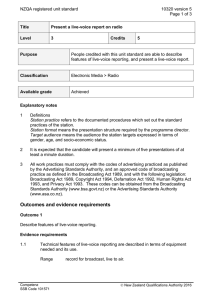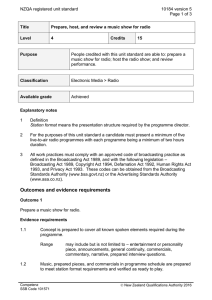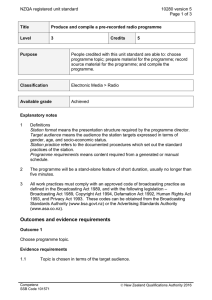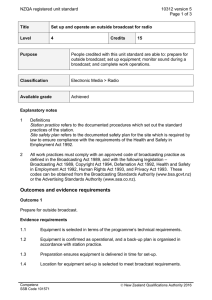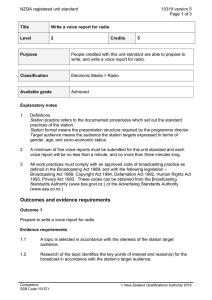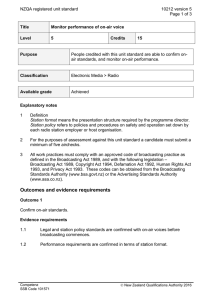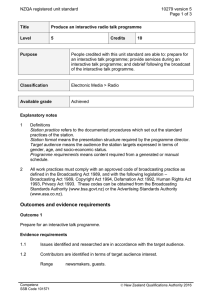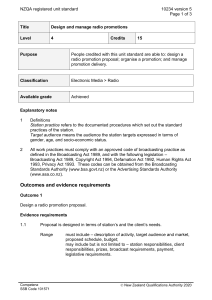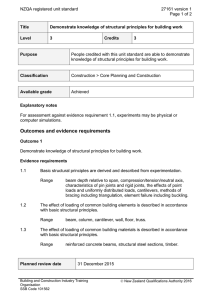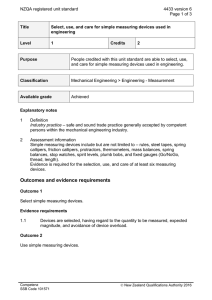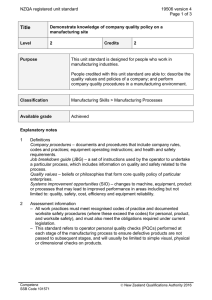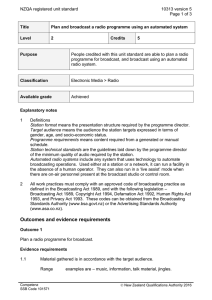NZQA registered unit standard 10183 version 5 Page 1 of 3
advertisement
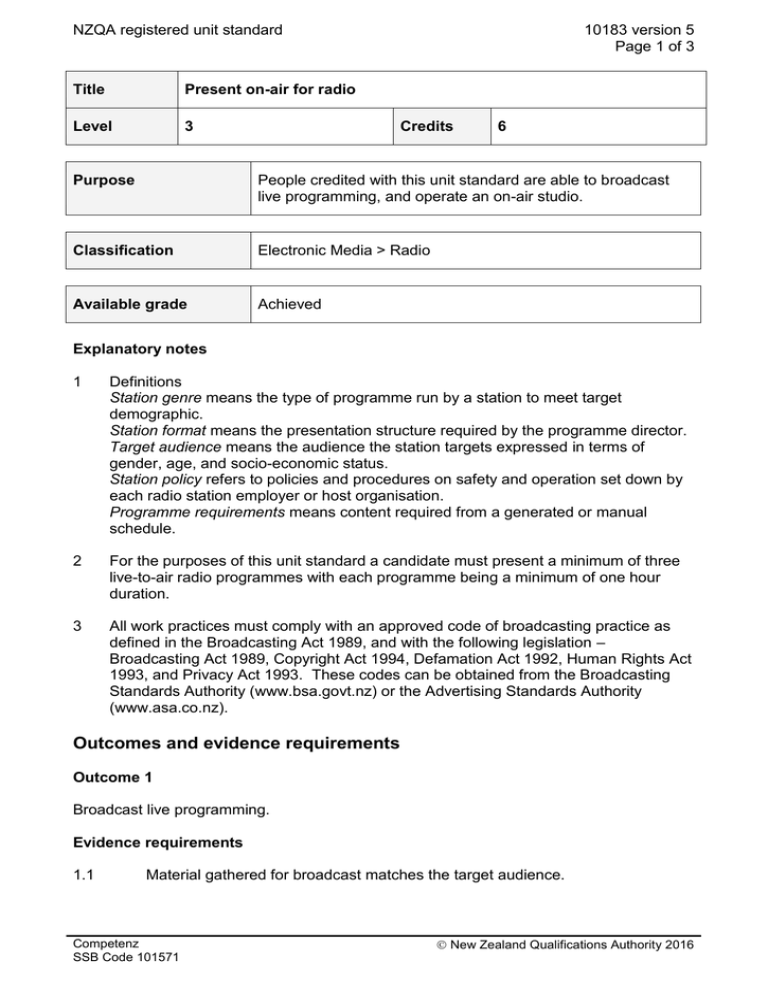
NZQA registered unit standard Title Present on-air for radio Level 3 10183 version 5 Page 1 of 3 Credits 6 Purpose People credited with this unit standard are able to broadcast live programming, and operate an on-air studio. Classification Electronic Media > Radio Available grade Achieved Explanatory notes 1 Definitions Station genre means the type of programme run by a station to meet target demographic. Station format means the presentation structure required by the programme director. Target audience means the audience the station targets expressed in terms of gender, age, and socio-economic status. Station policy refers to policies and procedures on safety and operation set down by each radio station employer or host organisation. Programme requirements means content required from a generated or manual schedule. 2 For the purposes of this unit standard a candidate must present a minimum of three live-to-air radio programmes with each programme being a minimum of one hour duration. 3 All work practices must comply with an approved code of broadcasting practice as defined in the Broadcasting Act 1989, and with the following legislation – Broadcasting Act 1989, Copyright Act 1994, Defamation Act 1992, Human Rights Act 1993, and Privacy Act 1993. These codes can be obtained from the Broadcasting Standards Authority (www.bsa.govt.nz) or the Advertising Standards Authority (www.asa.co.nz). Outcomes and evidence requirements Outcome 1 Broadcast live programming. Evidence requirements 1.1 Material gathered for broadcast matches the target audience. Competenz SSB Code 101571 New Zealand Qualifications Authority 2016 NZQA registered unit standard Range 1.2 may include but is not limited to – convincing, natural, one-to-one communication, use of ad-libbing. Content is presented in a manner which is clear and natural. Range 1.4 may include but is not limited to – news bulletins, commentary, opinion piece, personality piece, interview questions, review. Style of delivery is consistent with station format and genre. Range 1.3 10183 version 5 Page 2 of 3 inflection, pausation, articulation, pace. English, Māori, and non-English words used are pronounced correctly and match the target audience. Outcome 2 Operate an on-air studio. Range commercials, music, phone calls, voice breaks. Evidence requirements 2.1 Sound not intended for broadcast does not go to air. Range may include but is not limited to – dead air, multiple audio sources, microphone channel open. 2.2 Commercials, music, and news are played according to the programme schedule. 2.3 External audio sources are cued in to meet programme requirements. 2.4 Material is recorded for archives in accordance with legislated requirements. 2.5 Studio is left in accordance with station policy. Range may include but is not limited to – announce desk reset, automation activated, technical problems reported. Replacement information This unit standard replaced unit standard 1337. Planned review date 31 December 2016 Competenz SSB Code 101571 New Zealand Qualifications Authority 2016 NZQA registered unit standard 10183 version 5 Page 3 of 3 Status information and last date for assessment for superseded versions Process Version Date Last Date for Assessment Registration 1 28 February 1997 31 December 2010 Revision 2 11 March 1998 31 December 2010 Revision 3 8 February 2001 31 December 2010 Review 4 20 March 2009 31 December 2010 Review 5 18 February 2011 N/A Accreditation and Moderation Action Plan (AMAP) reference 0002 This AMAP can be accessed at http://www.nzqa.govt.nz/framework/search/index.do. Please note Providers must be granted consent to assess against standards (accredited) by NZQA, or an inter-institutional body with delegated authority for quality assurance, before they can report credits from assessment against unit standards or deliver courses of study leading to that assessment. Industry Training Organisations must be granted consent to assess against standards by NZQA before they can register credits from assessment against unit standards. Providers and Industry Training Organisations, which have been granted consent and which are assessing against unit standards must engage with the moderation system that applies to those standards. Consent requirements and an outline of the moderation system that applies to this standard are outlined in the Accreditation and Moderation Action Plan (AMAP). The AMAP also includes useful information about special requirements for organisations wishing to develop education and training programmes, such as minimum qualifications for tutors and assessors, and special resource requirements. Comments on this unit standard Please contact Competenz info@competenz.org.nz if you wish to suggest changes to the content of this unit standard. Competenz SSB Code 101571 New Zealand Qualifications Authority 2016
